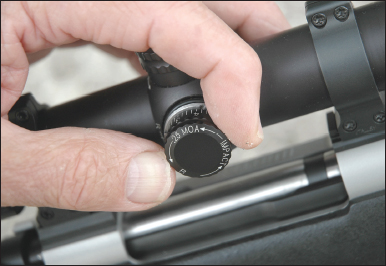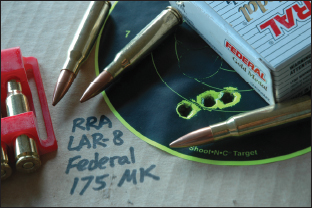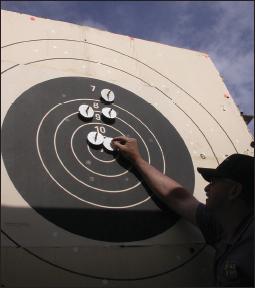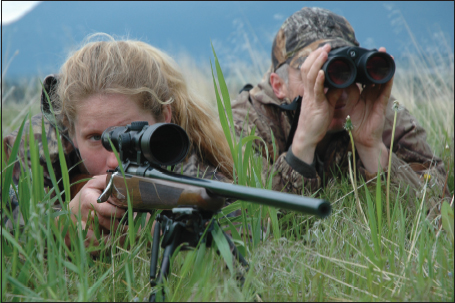27. Wind wisdom
If Wyoming weren’t anchored to Utah, Idaho and Montana, it might blow away. I’ve shot in wind from many quarters, but a Wyoming wind always gets my attention. It has a breadth and depth that makes the earth itself hunker down. A Wyoming wind bends thick trees and dulls the edges of big rocks. It has its way with little things like bullets.
I thought about that as I bellied into the short sage on the ridge and peeked through my 4x Lyman Challenger. Wind-tears blurring my aim, I snugged the sling and set the horizontal wire on the antelope’s back. Then I nudged the rifle against the wind—which seemed strong enough to push a 6mm spitzer into South Dakota. I let my lungs collapse and crushed the trigger. The buck ran off, then slowed as I cranked in another round. I doubled my wind allowance, holding the vertical wire well into the sage in front of the chest. The Remington 722 bounced again. My 90-grain Remington softpoint found the buck’s heart. He dashed away, stumbled and fell. Gravity had pulled my bullet nearly 18 inches low, and wind had moved it as far. No matter how accurate your rifle or how solid your position, you won’t hit if you ignore wind.

Adding a minute for wind drift, Wayne kept these five .243 bullets on the gong at 540 yards.

Long and lean, VLD (very low drag) bullets add effective reach, especially in wind.
Wind speed and angle both affect bullet flight. A “full-value” wind from 3 or 9 o’clock gives you the most trouble because, like gravity acting on a bullet fired horizontally, it is pushing at right angles to the bullet’s path. Vulnerability to wind also depends on bullet velocity and ballistic coefficient, or C. Bullets of similar C show about the same wind drift. Consider a quartet of Nosler Partitions: a 130-grain .270 bullet, a 140-grain 7mm, a 165-grain .308 and a 210-grain .338. All have essentially the same nose shape, and they have similar C values—from about .390 to .440. Launched at 3,000 fps, all these bullets drift about 6 inches at 200 yards in a 20-mph crosswind. Drop C to .289, with a 150-grain .308 protected-point bullet, and drift goes up 50 percent, to 9 inches.
A wind from 12 o’clock or 6 o’clock has essentially no effect unless it is very strong, and then the result may not be what you think. A bullet fired at a distant target across level ground is actually launched slightly nose-up and remains nose-up. Surface exposure due to the bullet’s in-flight attitude affects shot displacement. Unlike an arrow, a bullet is not heavy at the front and does not “porpoise.” You can ignore most head-winds and tail-winds. Remember that a bullet moving 3,000 fps bucks tremendous air resistance even in still conditions. It is, in fact, generating its own headwind—a 2,000-mph gale! What difference do you think a 20-mph head-wind or tail-wind will have on this bullet’s flight?

Excepting bullseye shooting in a prevailing wind, it’s usually best to shade, not click, for wind.
My introduction to wind came in smallbore prone matches. When I moved outside from indoor three-position, shooting, I felt as though I’d been plucked from a hotel pool and dropped into the North Atlantic. Outdoors, you had to hold, execute and dope the wind. To ignore the wind was to lose.
Wind flags and “windicators”—small, delicately mounted fans with tails that swung atop stems on ball bearings—kept me apprized of wind speed and direction. I soon learned to pay them close attention. Even a light breeze could shove a .22 bullet across a couple of scoring rings.
Sometimes windicators at the line wouldn’t catch a let-off or pick-up, or even a reversal. They’d hum lazily with nary a flip of their tails, while my bullets jumped in and out of the 10-ring. The flags at 50 and 100 yards, however, affirmed that downrange conditions were unstable. Wind at the target could even run opposite that at the line! I’d see flags in full flap at 100 yards, other flags limp at 50. Occasionally the windicators would spin furiously to the left, while the mid-range flag lifted to the right, and the 100-yard flag kicked out left again. A bullet sent through that gauntlet would, quite literally, chart a zig-zag course. Shooting during mixed signals was pretty risky. When the wind was visibly undecided, the spatter of shots at the line would die out as shooters waited for more favorable conditions.
Favorable didn’t necessarily mean still. It’s possible to shoot well in stiff breeze, as long as you’re zeroed for that condition or “shade” for it. Zeroed for predominate drift, you get more shooting time during a match. You can afford to hold your fire during let-offs and pickups, or at least reduce the number of shots you must fire under those conditions. Savvy shooters make notes about the wind on a range so they learn its idiosyncrasies. The Spokane rifle range, where I often competed, is on a river-bank. Wind typically angles across the firing line from 7 or 8 o’clock, then bounces off the bank and hits the targets from 4 o’clock. If you minded only wind at the line, you’d make a mistake. Wind may also vary from one end to the other on a firing line, depending on obstructions like trees and club houses, and the local terrain.
Hunting big game, you’re not using a .22 rimfire or shooting at X-rings the size of a dime. Bullets from most centerfire rifles can drive through pretty strong winds without significant deflection. Even a 170-grain flat-nose .30-30 bullet drifts less than 2 inches in a 10-mph full-value wind at 100 yards. A 25-mph wind, strong enough to sway trees, pushes that .30-30 bullet only 4 inches off course. Pointed bullets from .30-06-class cartridges buck the wind better. So at woods ranges, you really needn’t fret about the wind. Remember too that deflection is generally figured for wind at right angles to the bullet’s path. Even wind that howls through the trees and picks up small dogs and trash can lids has little effect at modest ranges if the angle is acute. But just as the trajectory of a bullet becomes steeper the farther it gets from the muzzle, so wind deflection becomes greater at long range. A constant wind is, in effect, much like gravity. Bullets scribe a parabolic arc under the press of wind for the same reasons their trajectory is parabolic.
Double the wind speed, and you double the drift. Halve the wind speed, and you halve the drift.
Reduce the wind’s angle from 90 degrees, and you reduce drift proportionately. Change the shot distance, however, and the drift may surprise you. For example, a 130-grain .270 bullet launched at 3,000 fps drifts less than an inch at 100 yards in a 10-mph wind. At 200 yards, it is 3 inches off course—four times as far as it was at 100! At 300 yards it drifts 7 inches, at 400, 13. There’s negligible drift at 100 yards because the bullet arrives in just 1/10 second. There’s not much drop at 100 yards either. While wind speed and angle determine actual deflection, adding distance dramatically increases drift for every bullet. In fact, wind drift for the .270 bullet at 500 yards is about 60 percent greater than at 400. For most popular big game loads, a handy rule of thumb is to assume an inch of drift at 100 yards, then double that at 200. Triple the 200 drift at 300 and double the 300 drift at 400. Here’s how that works for a 180-grain .30-06 bullet at 2,700 fps:
Drift for .30-06 bullet (180 grains) in 10-mph right-angle wind
| Actual drift (inches): | Rule of thumb drift (inches): | |
|---|---|---|
| 100 yards | 0.7 | 1 |
| 200 yards | 2.9 | 2 |
| 300 yards | 7.0 | 6 |
| 400 yards | 12.9 | 12 |
In this case, the estimate is within an inch of actual drift. Nobody I know can hold within an inch at 400 yards under field conditions, and darn few rifles will shoot even half that tight. If you’re shooting a .30-30 with a flat-nose bullet, the rule of thumb fails beyond 100 yards because the bullet is wind-sensitive and decelerating quickly. The rule works well enough for very fast bullets like a 140-grain spitzer at 3,300 fps from the 7 STW. Out to 300 yards, actual and estimated drift are close; but at 400 yards the STW bullet stays about 2 inches closer to line of sight than does the .30-06 bullet.
You might think the formula fails the .30-30 bullet because of its blunt nose. That’s true, in part. A bullet the shape of a soup can is not very well adapted for flight. There’s a lot of air pressure on the nose, a high rate of deceleration. But lightweight spitzers, like 70-grain .243s, also have low ballistic coefficients. Their low sectional density (ratio of a bullet’s weight to the square of its diameter) acts like a blunt nose to reduce C. A sleek bullet short for its diameter can have as much trouble cleaving air as a longer bullet with a blunt nose. The 70-grain .243 Nosler has a ballistic coefficient of .252; the .30-30’s is higher, at .268. Its pointed nose gives the .243 an advantage in wind. Drift at 100, 200, 300 and 400 yards is 1.0, 4.3, 10.3 and 19.7 inches respectively, while drift for the 170-grain .30-30 is 1.7, 7.6, 18,1 and 34.4. But both bullets give up more to the wind than do .30-06-class big game bullets. Velocity, by the way, is not a main factor until it drops well below “normal” for the distance. While the .30-30 starts sluggishly at 2,200 fps, 70-grain .243s give their dismal performance in wind after leaving the muzzle at 3,400 fps! Deceleration rates for both are substantial, contributing to their lack-luster performance in wind downrange.

A Rock River LAR-8—with AR-10-size action—likes this Federal load of wind-bucking 175s.
All else equal, fast bullets buck wind better than slow ones. For instance:
Deflection in a 10-mph, right-angle wind

A couple things are operating here. First, at 500 yards the .300 Winchester bullet drops 3 inches less than the same bullet from a .30-06. Not much difference, considering the 380 fps disparity in starting velocities. Note, though, that the 500-yard velocity spread is less than 200 fps. In other words, the .300 bullet slowed at a greater rate. Moving faster, it met stiffer air resistance, just as you feel the wind on your face grow stronger as you pedal faster on a bicycle.
Launched from a .30-30, a bullet of the same weight but with a blunt nose lags well behind the others and yields more readily to the wind. Though its muzzle speed comes within 80 percent of the .30-06’s, it drifts more than twice as far at 500 yards. Why? The .30-30 bullet has a low ballistic coefficient and decelerates much more rapidly. Its 500-yard velocity is only 40 percent of its launch speed. The ‘06 and .300 retain about 60 percent of initial velocity at that range. Rate of deceleration heavily influences long-range drop and drift. Muzzle speed, in fact, becomes all but irrelevant. Consider this comparison:
Deflection in a 10-mph, right-angle wind

These bullets leave the gate 700 fps apart but at 500 yards register nearly identical speeds. Drift is the same out to 300 yards, as the greater weight of the .308 bullet offsets the velocity edge of the .30-06. But at long range the heavier .308 bullet better resists wind. It is catching up to the 110-grain spitzer, whose rapid deceleration erases the speed advantage that held wind deflection even at the start.
Do heavier bullets always perform better in wind? Not always. A .223 bullet half the weight of the 110-grain .30-06 and started at about the same speed shows almost identical vulnerability to wind:
Deflection in a 10-mph, right-angle wind

Bullet weight, ballistic coefficient and velocity all affect drift because they all affect deceleration.
These three bullets show why you can’t ignore any of these factors:
Deflection in a 10-mph, right-angle wind

The 180-grain bullet from a .300 Weatherby, driven as fast as a 150-grain spitzer from the .300 Winchester (first block of figures) drifts 5 inches less at 500 yards, a function of the additional weight and 176 fps less lag at that range. Given the same bullet shape and diameter, you reduce deceleration as you add weight. Despite their greater surface area, heavier bullets resist crosswind better than do light ones,
The effect of deceleration is confirmed by the greater drift of the .375 bullet compared to the .458. Terminal velocities at 500 yards are nearly identical, but the .458 loses only about 800 fps en route, while the .375 drops 1,400 fps. (This .375 solid, incidentally, is one of the least aerodynamic of many .375 bullets available). So here the faster bullet drifts nearly a foot farther than the slower bullet—albeit the .375’s C value is only slightly lower than that of the .458’s. The great weight of the .458 bullet hikes inertia, which extends maximum range and reduces wind drift.
Sharp bullet tips have become popular of late, lending an aerodynamic shape to the missile. But it’s easy to assign too much importance to the bullet nose. Winchester ballistician Alan Corzine told me long ago that the first 1/10th inch of the nose can be flat, round or pointed without affecting trajectory or drift. The ogive—the leading curve of the bullet between tip and shank—matters more.
Boat-tail bullets become an asset only at very long ranges or in gale-force winds. A 30-mph wind that shoves a flat-base 7mm bullet 17 inches at 350 yards moves a boat-tail bullet 15-½ inches. The lesser drift afforded by a tapered heel at higher wind speeds is academic, given how hard it is to estimate drift in a wind that strong, or to hold a crosswire within a couple of inches at 350 yards. Also, percentage difference in wind deflection between the two bullets is about the same for a 10-mph wind and a 30-mph wind.

GreyBull manufactures load-specific dials easily retrofitted to Leupold scopes for long shooting.

Before you shoot long at game, shoot long at paper. It’s instructive—and humbling in wind.
No matter how well your bullet resists wind, hitting consistently at distance can depend on your ability to predict drift. To do that you must accurately read the wind.
Wind doping is an acquired skill. Early in my competitive shooting career, fellow rifleman Dick Nelson (who also helped Boeing engineer the first moon vehicle) took me aside. “Mind the mirage. Learn to read that, and your bullets will hop through the 10-ring like trained pigs.”

A young shooter puts her training to the test on the prairie. A steady rifle makes long shots possible.
Mirage is a visual distortion caused by heat waves rising from the earth’s surface. If you don’t see it, it isn’t there. Mirage does not move bullets; its dance shows you wind that does. Mirage can also show you a target that isn’t there, by “floating” the target image in the direction the air currents are moving. You can’t see mirage at all distances at once. You’ll either see the strongest mirage or the mirage at the range for which your scope is focused. To get the most information about the wind that most affects their bullets, match shooters typically focus their spotting scopes to read mirage just short of the targets.
Mirage that’s really bumpy and moving slowly indicates a light breeze. Mirage that’s flat and fast indicates stronger breeze. When mirage disappears suddenly with no change in light conditions, it’s often because the wind has picked up. Mirage that boils vertically shows you a still condition—but beware, as a boil commonly precedes a reversal in wind direction. Many competitive shooters zero for light prevailing breeze, then hold their fire during boils and reversals, shading and shooting during pick-ups and let-offs.
In the field, you may seldom see mirage. Fall hunting seasons bring cold weather, which all but cancels mirage. To read wind then, you must rely on coarser signs: nodding trees and grass, the leaves and snow and mist that yield to wind. Remember that wind at the target can be as important as wind up close, because downrange the bullet is moving slower, and wind has more time for any given distance to work its mischief. Wind at muzzle has great leverage, and you’re better able to read it—but it’s not the only wind that can make you miss!
Table of contents
- Title Page
- Dedication
- Copyright
- Acknowledgments
- Foreword
- CONTENTS
- INTRODUCTION
- SECTION I: BALLISTICS IN HISTORY
- SECTION II: THE MUSCLE BEHIND THE SHOT
- SECTION III: BULLETS—THE INSIDE STORY
- SECTION IV: SPEED, ENERGY, AND ARC
- SECTION V : PUTTING BALLISTICS TO WORK
- SECTION VI: FOR LONGER REACH
- BALLISTICS TABLES FOR MODERN SPORTING RIFLES
- GLOSSARY